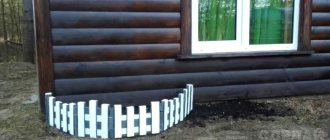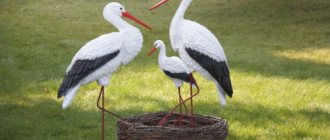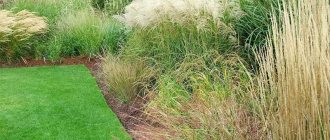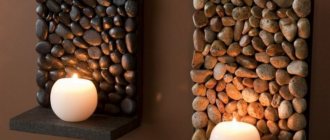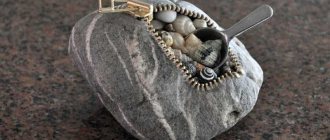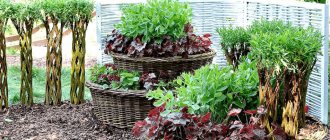Review author: Terrari School of Design
Topiary is the art of growing trees and shrubs in the form of living sculptures: cubes, spheres, obelisks, animal figures or combinations thereof.
Topiary pieces are great for adding architectural style and clean lines to your garden, are also a great way to introduce children to gardening, and are a great gift for anyone looking for a new relaxing and rewarding pastime.
Photos of topiary with interesting shapes have become increasingly common on the Internet in the last few years. But the history of topiary is much longer: it dates back to the times of Ancient Rome and Egypt. The practice was later revived in Europe during the Italian Renaissance and then became popular in seventeenth-century England.
Which plant to choose for topiary
Only certain plants are suitable for pruning topiary. The ideal plant for topiary is one that is slow growing, resistant to repeated pruning, and capable of repeated pruning. Small leaves are essential to create a clean-edged surface, especially for small topiaries viewed from close up.
If possible, select a species or variety whose natural form approximates the intended form.
Evergreens are usually used for topiary art, but deciduous plants such as English hawthorn or European beech are sometimes used. The downside of deciduous topiary, of course, is that it is bare in winter (although beech does not shed its dead leaves until spring).
Deciduous plants tend to grow more vigorously than evergreens, so they also require more diligence to keep growth under control.
Many types of evergreen plants have been used for topiary. The most important of these are yew and boxwood. Some other suitable plants include arborvitae, hemlock, holly and rosemary.
History of art
Plants have been used to improve land since time immemorial, but at a certain point things began to change. Curly cutting of plants first appeared in Europe, on the territory of the Roman Empire, during its prosperity.
At the first stages, everything was quite simple - bushes and trees received square or round shapes, thereby becoming more neat and unusual.
If you now look at photos of topiary on the Internet, you can find plants of any shape and type, because now this art is more developed than ever before.
The art of topiary experienced a huge leap in development during the Renaissance. During this period of history, topiary figures not only began to be actively used, this technique was used to create entire garden systems, some of which are still preserved, such as garden labyrinths in France, although they have undergone some changes.
A distinctive feature of this time period was that gardeners stopped limiting themselves to simple geometric shapes and began to depict living creatures and other complex objects.
At that time, the capital of topiary development was the French Versailles, to which some cities in Holland can be added.
The Netherlands plays an important role in this regard, primarily because it was from this country that topiary came to the territory of modern England, where it is preserved and actively used to this day.
In fact, the art itself is much more interesting and complex than its, at first glance, unusual name. It originates from Latin from the words topiaria and topiarus - the art of gardening and gardener, respectively.
The art of topiary is associated with another term – topia, which means “small landscape”.
This is how gardeners initially presented their work - individual paintings, large or small, that are part of the site, but at the same time self-sufficient and independent.
It is also interesting that the first gardener who began to actively practice this art is a man who was considered a friend by Emperor Augustus and Julius Caesar himself. This amazing person is Knei Matii, who lived in the last century of the last era.
- Evergreens - a complete list with descriptions and recommendations from a gardener
Vertical gardening - from idea to implementation, choosing options according to budget and attractiveness (photo + video)
- Vertical flower beds - basic principles and rules for choosing plants and arranging a suburban area with your own hands
His work with plants surprised not only Caesar, but also other high-ranking officials of the Roman Empire, and therefore in the future they were described in detail in the book “Natural History”, which was written by the consul of the Roman Empire.
Despite all this data, many believe that the Persian peoples were the first to make topiary, and the Romans eventually simply borrowed this art.
It’s difficult to say how much truth there is in this, although there are some records that topiary tree trimming was used even earlier in the territory of modern Egypt.
Developing Your Form
In most cases, start shaping your plant when it is young. However, you could make a topiary out of an old, overgrown yew because yew grows densely and sprouts freely during the growing season.
Perhaps the growing plant will suggest a form that you can then develop. You can even juxtapose two plants or let one grow through the other to create, for example, a pedestal on which an animal figure sits.
In any case, topiary lends itself more to bold shapes than intricate patterns whose details are swallowed up between trims. Position the topiary so that it is well lit from all sides so that it grows over the entire surface.
Most young topiaries that are still in the formative stage require nothing more than frequent pruning or trimming of stem ends to promote dense branching.
Trimming individual stems is the preferred method for plants with large leaves, as trimming will damage individual leaves. Obviously, if the stem is sticking out in the direction you want it to grow, leave it.
Boxwood topiary art. Parc Topier in Durbuy
It's spring outside. A new tourist season begins. Maybe some of you will go to Belgium, because there is something to see here.
One of the attractions of Wallonia, one of the three regions of Belgium, is Topier Park in the small town of Durbuy. With only 300 residents, tourism is the main source of income here.
As soon as you approach the parking lot, a beautiful view of Durbuy Castle opens up. The castle is privately owned. And entry there is prohibited. All that remains is to admire from afar.
So what is remarkable about this Topier park? A little history.
The word Topiarus has Roman roots and means gardener. Although it is believed that the birthplace of the art of topiers is Persia and ancient Egypt. Ars topiaria means garden art. In English it is written topiary, in French art topiaire. The history of this type of art of topiary - decorative pruning of trees - goes back thousands of years. Egyptian grave monuments, Persian miniatures and Roman frescoes depict plants given a special form. The art of creating figures using the method of topiary cutting of bushes and trees was brought to Rome by Egyptian slaves.
During the period of the Roman Empire, such an order was established: in all gardens and vegetable gardens at the monasteries, low hedges of trimmed bushes were stretched around the beds with vegetables and herbs.
During the Renaissance, this type of garden art became more vibrant. In the architecture of castles and land holdings adjacent to them, geometrically trimmed terraces and labyrinths began to be used. Flower beds looked like paintings in a valuable frame. In the center of the picture there are greenery and flowers, and the frame was made of boxwood, lavender, and vermouth. An example of this era was the design of Villandry Castle. His garden was skillfully designed in the form of a hedge of bushes with alternating “carved” hearts, butterflies, masks and arrows in a certain order. It is called the garden of love.
Beginning in the early 17th century, the court architect of one of the castles developed a plan for a Baroque park. This became an integral part of the overall concept of the castle's architectural design. The new style quickly spread throughout Europe. The garden of Versailles was designed in this style. Hornbeam, boxwood, stone, wood and water - geometric shapes were created from these living and non-living materials. And multi-colored ornaments made from plants, they were called embroideries, were real masterpieces of garden art.
One of the castles in France where topiary art is used, today: In the mid-19th century, a new direction in the art of topiary was invented. They began to use a metal frame, inside which the plant was planted.
For example, this one is in the shape of a squirrel.
The plant grows and fills the form. All that remains is to trim the plant according to the contours of this shape.
As the starting material, upright evergreen shrubs with many small dense leaves are used, for example, boxwood, yew, holly, cotoneaster, thuja, hornbeam, privet...
The most commonly used topiary tree (shrub) is boxwood.
And here is a little about boxwood:
Nowadays this most interesting trend in landscape architecture is called topiary.
Let's return to the park. Topiary Park in Durbuy was created on the initiative of the Navez couple. First, A.Navez bought several ornamental bushes and began experimenting. At first it was just a hobby. Then it grew into a lifelong endeavor. A topiary park with sculptures made from plants was opened in 1997. As if in a fairy tale, 250 “sculptures” live here, these are both real people and fictional characters. The main “material” is boxwood. It grows for a very long time and therefore some boxwood figures are more than 50 years old.
At the entrance we are greeted by this figure of a man.
There are many animal figures located here. True, the height of such a figurine sometimes reaches several meters. So in the next photo in the far background you can see (if you look closely) the figure of an elephant. The height of the “elephant” is about four meters.
Horsemen, though with heads...
Squirrels seem to be alive...
Beautiful - isn't it?
And here is the figure of a bathing woman. Here she really seems to be bathed in the rays of the sun.
And even Pamela Anderson perched under an umbrella here.
"Ah, what a woman!" It's worth showing it close up:
The entire exhibition is outdoors. Many come here with children, this is a place for them to enjoy, if of course they are lucky with the weather.
Saving the form
Once the topiary is fully grown and formed, it needs to be pruned at least once a year, and in some cases two or three times a year.
If the plant only needs pruning once a year and is frost-hardy, prune just after mid-summer. By then the spring flush of growth has stopped and pruning is less likely to stimulate regrowth until the following spring.
Cut by hand or use a guide to ensure that the topiary does not change shape over the years. Guidance regarding guides is also useful if you have several suitable topiaries. If you're cutting by hand, step back often to check and admire your work.
What to do with neglected topiary? Severe cutting may be required to stimulate plant growth. If major cutting is necessary, restoration is only possible if the plant is able to germinate from the old, possibly leafless wood. Otherwise, start over with a new plant.
Coniferous specimens
Topiary figures made from conifers are good because they will delight the owner all year round. Evergreens grow slower. This will affect the duration of creation of the compositions, but caring for them is also easier.
Among the options in this group, the following types attract attention:
- thuja occidentalis;
- Siberian larch;
- boxwood;
- spruce or spruce;
- fir.
Another undeniable advantage of using conifers: a wonderful aroma. The figurines will delight you not only with their beauty, but also with their useful properties.
Trimming and shaping
If you want to make your own beautiful trimmed garden area, then we have some useful tips for you:
- Select the plant that best suits your garden conditions and the shape you are looking for.
- Choose a design that suits the conditions in which it will grow. The growth of some plants can indicate design.
- Remember that your plant will start out small but will continue to grow, so some may require more care than others.
- Trimming tools will range from hand tools, such as special trimming shears, to large electric shears, depending on the size of your project.
- When shaping the plant, make sure you wear gloves to protect your hands, and take care to protect your eyes and ears when using motorized clippers.
- Start with one young plant or several small plants located close together.
- You can use a topiary frame to hand shape your plant into the design or shape you want.
- Do not prune plants in very hot or cold weather; spring is the best time to do this.
Plant selection
Before choosing and purchasing a plant, you must first figure out what shape you should end up with. The first step is to determine its size, because this is the most important variable.
Next, you need to understand what shape the figure will have, because some plants are more suitable for certain shapes and types of figures.
Choosing the right plant will make the growing process much easier, not to mention the formation and subsequent care.
Let's start small - shrubs. Shrubs are the most popular option when creating topiary, because they themselves are not very large and their branches are quite thin, which is important when forming. Next come coniferous shrubs and trees.
They are already larger in size, and therefore suitable for medium-sized figures. If this option does not suit you, look at deciduous trees like apple or pear, instead of which elm or maple may be suitable.
DIY topiary
Prune the bush to its basic shape when it is young, preferably by the time it reaches a height of 0.60 meters. It can be an oval or square, which can later be cut into a more complex shape, or a cone, which can remain a cone or become a spiral.
Bend the chicken wire into the desired shape and size. If necessary, use zip ties to secure the ends of the wire. Build the frame outside next to the bush you plan to shape to make it easier to position the frame over the bush as you assemble it. It should be able to slide along the top of the bush and remain stable as the bush grows into the frame.
Ideally, the frame should be at least a few centimeters larger than the existing bush, allowing you to shape it as it grows. Simple shapes, such as squares or cones, may not require frames.
Place the frame above the bush if you are creating a complex shape. Secure with pegs.
Trim the outer branches of the bush with pruning shears. Form your own topiary garden by trimming any branch that sticks out of the frame, or stand back and study the overall shape as you trim if you're not using a frame.
For best results, trim just a few inches of each branch at a time. You can always trim more if necessary, but trimming too much can distort the shape.
Prune the bush to maintain its shape at least once a month during the growing season, which usually runs from early spring to late summer.
Trim only new growth that extends beyond your form, as well as dead branches inside the bush. It may take several growing seasons for the form to reach its full potential.
Ways to carefully form a crown
Relying on the eye when creating a green sculpture is not the best solution. Errors in crown formation are difficult to correct. It will take a lot of time to fix errors.
It is better to make sculptures, even the most basic ones, using ready-made templates. If you can’t use frames, you can make do with improvised means. For example, it is easy to use a cardboard arc to make a ball.
To form a cube, a stretched rope is enough to mark the smooth edge of the border. To make a cone, you can use slats that are installed at the desired angle.
When designing a complex composition, you cannot do without a frame. The skeleton does not have to be permanent. You can remove the base after cutting if you get the expected result. If correction is necessary, the frame is left for a longer period.


